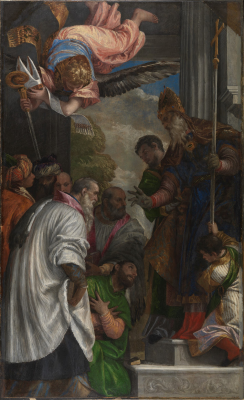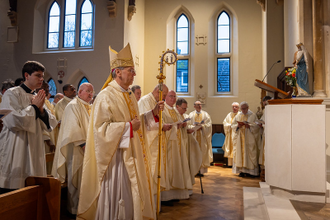National Gallery to reunite painting with Italian church for first time in 200 years

Paolo Veronese The Consecration of St Nicholas ©The National Gallery, London
The National Gallery is to bring a 16th-century altarpiece back to the chapel for which it was created, for the first time in over 200 years, through a new digital experience. Visitors to the Gallery will experience Veronese's painting The Consecration of Saint Nicholas as it would have been seen in its original Italian church setting in 1562 by using virtual reality headsets. The free digital exhibition will be available in 20-minute ticketed sessions that will be available from the Gallery's website from late January.
Through this innovative experience, visitors will be able to see the painting in its original chapel in the church of San Benedetto al Po, near Mantua, and explore the beautiful frescoes and architecture that once surrounded it. Visitors will be able to choose from one of two virtual guides who will lead them through the experience: our curator, Dr Rebecca Gill, who explores the painting and frescoes, or the historical figure of Abbot Asola, who commissioned the painting from Veronese and reveals the threat facing the monastery at the time.
Virtual Veronese, which creates a 3D model of the chapel, began as a research and development project looking at how the Gallery can share research with a wider audience by using immersive technologies to explore new ways of telling its stories.
Veronese's The Consecration of Saint Nicholas was commissioned in 1561 as an altarpiece to hang in San Benedetto al Po, the abbey church of one of the largest and most important Benedictine monasteries in Europe.
The church had been radically re-modelled and enlarged in 1539 by Giulio Romano, Raphael's prime pupil and himself a great painter and architect.
The altarpiece remained in San Benedetto al Po until the 1820s, when it was removed from the church during the Napoleonic Wars.
Veronese's painting shows St Nicholas's consecration as bishop, as told in the Golden Legend. On the eve of the election of a new bishop at Myra, a voice revealed that a pious youth called Nicholas had been divinely chosen and would be the first to appear at the cathedral door in the morning.
Veronese depicts the entrance of the cathedral, where the senior bishop consecrates Nicholas, who kneels wearing a robe of emerald green, flanked by two older priests in white surplices. An angel descends with a bishop's mitre and crosier, proving that Nicholas has been chosen by God. The turbans worn by two of the witnesses show the story is taking place in Asia Minor. The consecration of Saint Nicholas is included in cycles of paintings of his life, but this is one of only two other independent images of the subject produced before the end of the sixteenth century. It seems to have been chosen to illustrate the importance of the call to the priesthood, and of God's authority vested in a bishop.
Saint Nicholas kneels at the lowest point of the deep 'V' shape formed by the figures. The brilliant green of his robe is included elsewhere, creating a pattern of colour which, with the repeated rich pink, blue and white, draws our eye around the composition. Tiny dots and brushstrokes of white and yellow suggest the striped gold fabric covering the shoulders of the senior bishop. Streaks of white and grey define the folds and form of the foremost priest's brightly lit white robe. Veronese paints just enough detail and then allows our eyes to do the rest.
Giorgio Vasari, the 16th-century artists' biographer, highly praised this painting in his Lives of the Artists. It was painted for the abbey church of S. Benedetto Po, just south of Mantua, following its reconstruction under the direction of Giulio Romano. Veronese was commissioned on 27 December 1561 to paint three altarpieces with subjects from the lives of Saint Nicholas, Saint Anthony Abbot and Saint Jerome. A transcription of a lost document recording the commission says they were to be painted in the best available colours and specifies the payment the artist was to receive.
Veronese received final payment for the altarpieces on 30 March 1562, so he either started before the commission was formally recorded or he worked at incredible speed, the three paintings only taking him three months. The original architectural frames, which may have been designed by Giulio Romano, are lost.
The altarpiece of Saint Nicholas was taken from the abbey church and sold on the orders of Napoleon Bonaparte, when the French general took Mantua in 1797. It was purchased in 1811 by the governors of the 'British Institution for Promoting the Fine Arts in the United Kingdom'. It was the first old master painting to be acquired by them, and they intended it to adorn a 'future National Gallery'.
The digital experience is accompanied by a recording of Gregorian chant, performed by Veneti Cantores. The piece of music is taken from a choral book that was produced at San Benedetto al Po in the 1560s and is therefore contemporary with Veronese's altarpiece. The music that you hear is the same as that performed by the monks nearly 500 years ago.
Lawrence Chiles, Head of Digital at the National Gallery, London, says: " 'Virtual Veronese' has enabled us to understand how immersive storytelling can add depth of experience, meaning, and emotion to Gallery visitors' engagement with our paintings."
Dr Rebecca Gill, Ahmanson Curator in Art and Religion (August 2016 - March 2020), at the National Gallery, London, says: "Through this project we are able to bring architecture into the Gallery and allow our visitors to explore for themselves what it might have been like to stand in front of Veronese's painting some 500 years ago."
Virtual Veronese is curated by Dr Rebecca Gill, Ahmanson Curator in Art and Religion (August 2016 - March 2020), at the National Gallery, London.
This experience is for visitors aged 13 years or over.
Ticketing details will be announced in January.
This experience will be free to enter, and will be available to visitors who have booked Gallery Entry tickets as well as tickets to other Gallery exhibitions. Simply make your way to Gallery Room F to enjoy Virtual Veronese.
LINK
National Gallery - www.nationalgallery.org.uk/


















